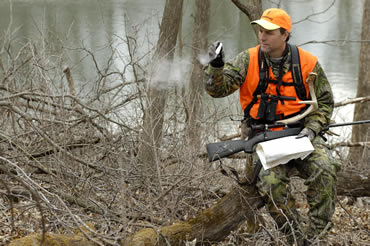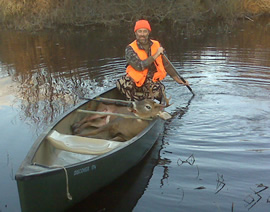A look at whitetail bedding areas and how they’re important to hunters.
My son Ben and I made our way to within 100 yards of our double ladder stand. “We’re gonna have to be as quiet as we can from here on,” I said. He understood why and nodded. We moved slowly and quietly, inching forward only when the wind blew, then crept up and settled into the stand. So far, so good.
It was barely an hour and a half into our vigil when we heard something stir in the tall reeds and cattails. Moments later, a big doe popped into view. She didn’t arrive. She’d been right in front of us the whole time, bedded less than 75 yards away. We just couldn’t see her until she rose to her feet.
I fought the sudden surge of adrenaline then talked my son through it. “Don’t rush,” I whispered. “Wait until you have a clear shot.”
The deer angled slowly toward us, then turned and headed for the woods. I was shaking as badly as Ben. A loud blaat on my grunt call stopped the doe, giving him a perfect broadside shot. His rifle roared, and the doe took several bounds before collapsing.
The suddenness of her appearance took us both by surprise, despite the fact we were somewhat expecting it. In fact, it was the reason we were there.
We’d located the spot the previous fall when we jumped several deer from their beds. We erected the double ladder the following summer. Our plan was to wait until the wind was right, and then slip in to the stand as quietly as possible in hopes the deer would be resting in front of us. Darned if it didn’t work. Furthermore, the ancient doe dressed out at 145 pounds. We’d outwitted a real trophy. It wasn’t the first time I’d used that tactic with similar results.
BED TIME
Of all the types of habitat deer use, bedding areas are probably the least understood and least utilized by hunters. Go back through your stack of Buckmasters for the past several years and look at what the articles focus on: feeding areas, funnels and travel corridors. Most advise to stay away from bedding habitat, which is ironic when you consider whitetails spend 70 percent or more of every day bedded.
It only stands to reason if you spend more time where deer spend the most time, you’ll see more of them.
But that’s easier said than done.
Hunting in and around bedding areas requires extra attention to detail.
 WHAT THEY ARE
WHAT THEY ARE
To exploit bedding areas you need to find them, which requires you to be able to recognize them. Unfortunately, bedding areas seldom meet neatly defined criteria. Whitetails are found in a di-verse range of habitats, and they don’t read books and magazines to know they’re supposed to bed in a particular type of habitat.
Still, there are some commonalities.
In mountainous terrain, deer tend to move up in the morning, bed high during the day then move down at night. I saw an exception in Wyoming when I found them bedded in the woody draws at the base of steep hills.
In agricultural country, whitetails often lay up in the thickets during the day and move into the fields at dusk. In eastern Montana, however, I’ve seen them suddenly pop up out of their beds in the middle of a 100-acre alfalfa field.
In the northern forests, they tend to seek the thickest, nastiest cover they can find, but I’ve jumped them so close to houses I couldn’t shoot.
The point is, you can be confident, but never sure.
Midwest hunters have it about as easy as it gets. Once the corn is cut, the only cover left is grassy swales, narrow windrows and small patches of timber, and that’s where the deer bed.
It also helps to understand general bedding behavior patterns. Deer are most active at dawn and dusk, with activity levels progressively decreasing as you move away from these peaks in either direction.
While most deer follow the same major pattern, radio collar studies have documented a minor pattern contrary to what most people think. Although deer remain relatively inactive outside of peak periods, they do move. I assisted with a radio collar study in Massachusetts that found deer seldom remained in the same bed more than an hour. They would periodically get up to stretch and move a few feet before lying down again.
Whitetails also use different beds at different times of day. My observation has been they might bed close to, or even in, nighttime feeding areas, but move off to more secluded or protected areas for their day beds. Studies have also shown they might move closer to feeding areas, and then stage or even bed for a short time before moving out to feed in the late afternoon.
These are all things to keep in mind when laying out your plan of attack.
APPROACH
Approach is everything when it comes to hunting in and around bedding areas, and this applies to both timing and direction. Deer typically bed in areas where they can use wind, cover and ter-rain to their advantage. For example, they might position themselves with the wind and the thickest cover at their back and an open view in front, all of which make it easier for them to detect danger. They don’t use reason and deduction to locate these areas. It’s more a matter of learning, through experience, where they will be the safest and least disturbed. That’s why the oldest deer typically have the best, safest bedding areas.
Wind is always a factor when hunting, but especially when working around bedding areas. You have to approach from downwind and set up downwind. And if you mess up, chances are you’ve burned that stand, and quite possibly the bedding area, for good.
You also need to minimize evidence of your intrusion.
Be meticulous with scent control, particularly on clothing, shoes or anything that will potentially leave human odor in the environment. Try to approach from a direction the deer don’t use. Scent can linger for days, and a wise old buck might detect you long after you’ve gone. If he does, he won’t be back.
Sometimes you have to be creative. I once located a prime bedding area where a stealthy approach seemed impossible. Coming in from the north or west, I’d have the wind at my back. Cover to the south was nearly impenetrable, and the east side was protected by a river. Instead of protection for the deer, the water provided a stealthy avenue of approach for me — by canoe. I slipped in early one morning and caught a buck coming in to use a bed he never reached.
In open country where deer can see a long way off, foot approach is sometimes not an option. You wouldn’t ordinarily think of motorized vehicles as a means for approaching bedding areas, but deer become accustomed to regular vehicle traffic like farm equipment and even ATVs. In such cases, get someone to drive you to your stand.
 TIMING
TIMING
In the early season, days are long and temperatures warm. Deer are still in their late summer patterns, which means they’re not moving until the very last minutes of daylight and returning to bedding areas very early in the morning. That is particularly true of bucks.
You might never see them unless you’re right up against bedding cover.
I learned this by accident, and by taking a cautious approach. I was hunting a funnel connecting a dense thicket of bedding cover with a larger block of open, mast-producing hardwoods. There was a ton of sign, but I wasn’t seeing deer. I learned why when I set up cameras. The deer were going through every day, just too early and too late. I incrementally moved closer to bedding areas until I eventually hit the hot spot. I have since killed three nice bucks and missed a fourth out of that same stand, and all those encounters came within the final 10 minutes of shooting light.
Much the same is true of pressured deer, and the more you pressure them, the more nocturnal they become. That’s why it’s better to take a cautious, incremental approach to hunting near bedding areas. Cameras can tell you when deer are moving through and if you need to move.
Timing also applies to when you should approach. Just because you’re hunting only the very first and last hours of the day doesn’t mean you can go in to your stand later. In fact, for the reasons already mentioned, you need to get into your afternoon stand well in advance of anticipated movement. Deer might be moving incrementally closer to feeding areas throughout the early afternoon, and you don’t want to get caught moving in while they’re moving out.
During morning hunts, there’s a good chance some deer will be moving back to bed before daylight. You need to get there ahead of them, or you might never see the daylight movers.
CONGRUENCE
There’s an axiom that all things in nature move toward entropy. Humans like to place things into neat categories, while nature prefers disorder and chaos.
I’d like to be able to define bedding cover as one thing and travel areas and feeding cover as another, but I can’t. That’s partly because of the aforementioned variability, but also because bed-ding, feeding and travel areas are not mutually exclusive.
One of my all-time best bow stands overlooks a fallow apple tree that’s smack dab in the middle of prime bedding cover. My first bow kill came near the top of an open oak ridge that was dimpled with day beds. The whitetails in both those cases were literally bedding in their food.
DICHOTOMY
Like humans, deer are individuals, and each can act differently.
Does tend to be more social and are more inclined to bed with other deer. Bucks tend to be less social and more inclined to seek solitude. Older ones tend to bed in safer, more secluded areas.
You can use that knowledge to your advantage. Outside the rut, look for single, large beds in secluded areas. When the rut hits, bucks will be targeting doe groups, and so should you. Set up just downwind of doe bedding areas where bucks will be cruising to scent-check for hot does.
FINALLY
How, when and where you hunt bedding areas depends on specific, localized circumstances. In all cases, consider what areas offer deer the best chance to detect and escape danger. Then you need to figure out how to get as close as possible without being detected. Wait until conditions are right and hunt these stands conservatively. They’re special places that can produce special results.
Read Recent Articles:
• Get Up and Go! You need a Plan B when treestands and food plot vigils aren’t working.
• The Long Haul: The more time you spend in the woods, the better your odds for success.
• How to Get Bow-Close: Advice from this traditional bowhunter can help you be in the right spot.
This article was published in the August 2011 edition of Buckmasters Whitetail Magazine. Subscribe today to have Buckmasters delivered to your home.